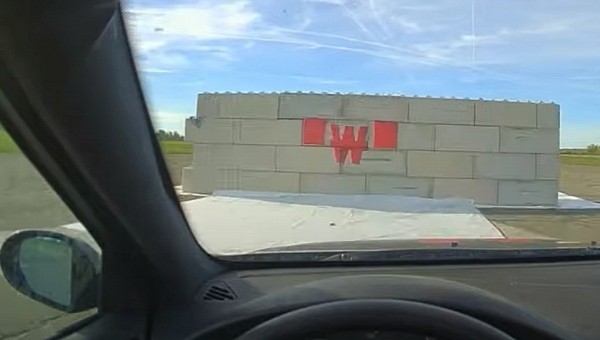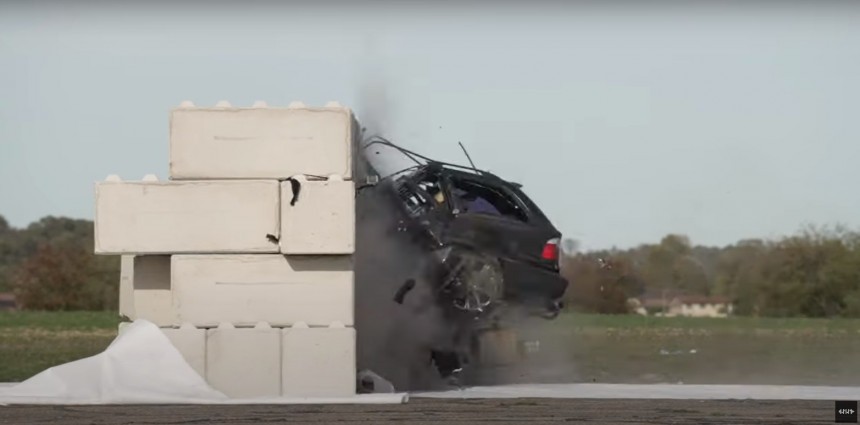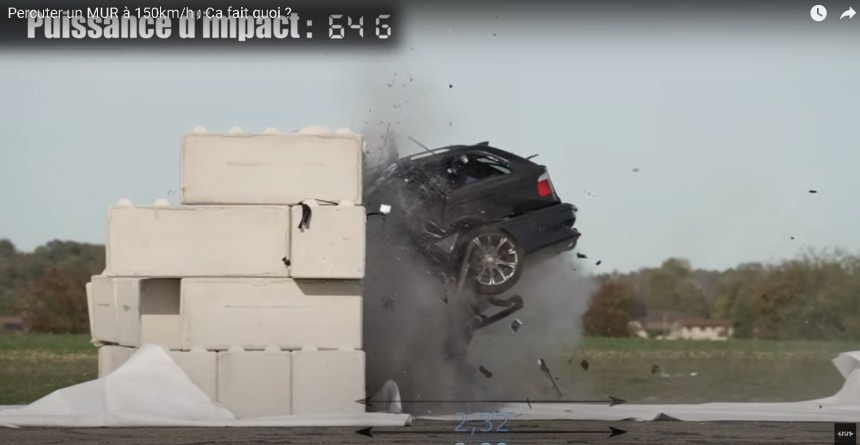This week, a video of a BMW E39 Touring gathered quite a bit of views as it was remotely driven into a wall at high speed. It is impressive to see that technology allows independent content creators the ability to do things like these, but that is not the purpose of this article. Instead, I suggest you take a close look at what happens in the impact.
This type of accident is not that common, but it may happen. The idea was to portray an older vehicle that was driving at high speed but far from its maximum abilities as it hit a solid barrier. There are other vehicles that could have been used, other barriers, and so many other alternatives, but let us not get sidetracked here.
Take a good look at this BMW 5 Series Touring as it is driven with a remote control up to a speed of 93 mph (150 kph) straight into a wall. The French team who put this test together had a one-kilometer-long (0.6-mile) track, which was not enough to let the vehicle reach 200 kph (120 mph), so the test was done at a lower velocity than what was initially planned.
Still, this is thrice as fast as a regular crash test. In case you were unaware of that aspect, modern-day crash tests have been taking place at 50 kph at EuroNCAP and 35 mph (ca. 56 kph) at U.S. NCAP tests.
The answer is linked both to physics and human physiology, as kinetic energy is proportional to the square of the speed, so if you are going 70 mph (ca. 113 kph) instead of 35 mph (ca. 56 kph), for example, you are dealing with four times the kinetic energy.
Second, the issue with high-speed crashes and the human body is that stopping from such a high velocity into an immovable object, such as a concrete wall, or a large barrier, involves G forces that are too high for the human body to withstand.
Survival in those situations becomes an incredibly fortunate exception that possibly included a bit of deceleration, not the norm, as it depends on too many factors, and the human body cannot be improved to tolerate the increase in force.
In other words, even if this 5 Series of the E39 generation would have been intact after the impact, if a person were sitting inside it while experiencing the sudden deceleration from 150 kph (93 mph) to zero, the occupant would not have survived the impact.
The problem involves the brain hitting the skull with excessive force, which makes the vehicle where it happens irrelevant when it takes place at such a high velocity.
As you may be aware, those crash test dummies have various sensors inside them, including G sensors that are designed to fail at a certain level, thus simulating the maximum force that can be withstood by the equivalent organ in the average-sized healthy human.
To be fair, this is the worst possible scenario in a crash, as it involves driving faster than the speed limit on a highway in any country (apart from no-limit sections on the German Autobahn) and then hitting a wall without the slightest attempt to slow down. It could happen in real life, though, and that is why you never sit in your vehicle or let anyone sit in a vehicle that is stopped on the emergency lane of the highway.
It does not matter if it is raining, snowing, or if it is too hot outside. The risk of getting rear-ended by a vehicle that is driving at highway speeds is too great to make it remotely safe to sit in a vehicle that is stopped on the emergency lane.
Moreover, I can only hope that this video, which has already gathered over two million views in three days, will be seen by those who are most likely to go speeding through the city. Don't do it, folks, as you might kill somebody, as well as get yourself killed.
The impact shown in the video below tops out at 64 G, which is more than enough to bring life-threatening injuries to any human. If you really want to drive your car as hard as you can, please do it on the track, not in the city.
Take a good look at this BMW 5 Series Touring as it is driven with a remote control up to a speed of 93 mph (150 kph) straight into a wall. The French team who put this test together had a one-kilometer-long (0.6-mile) track, which was not enough to let the vehicle reach 200 kph (120 mph), so the test was done at a lower velocity than what was initially planned.
Still, this is thrice as fast as a regular crash test. In case you were unaware of that aspect, modern-day crash tests have been taking place at 50 kph at EuroNCAP and 35 mph (ca. 56 kph) at U.S. NCAP tests.
The answer is linked both to physics and human physiology, as kinetic energy is proportional to the square of the speed, so if you are going 70 mph (ca. 113 kph) instead of 35 mph (ca. 56 kph), for example, you are dealing with four times the kinetic energy.
Survival in those situations becomes an incredibly fortunate exception that possibly included a bit of deceleration, not the norm, as it depends on too many factors, and the human body cannot be improved to tolerate the increase in force.
In other words, even if this 5 Series of the E39 generation would have been intact after the impact, if a person were sitting inside it while experiencing the sudden deceleration from 150 kph (93 mph) to zero, the occupant would not have survived the impact.
The problem involves the brain hitting the skull with excessive force, which makes the vehicle where it happens irrelevant when it takes place at such a high velocity.
To be fair, this is the worst possible scenario in a crash, as it involves driving faster than the speed limit on a highway in any country (apart from no-limit sections on the German Autobahn) and then hitting a wall without the slightest attempt to slow down. It could happen in real life, though, and that is why you never sit in your vehicle or let anyone sit in a vehicle that is stopped on the emergency lane of the highway.
It does not matter if it is raining, snowing, or if it is too hot outside. The risk of getting rear-ended by a vehicle that is driving at highway speeds is too great to make it remotely safe to sit in a vehicle that is stopped on the emergency lane.
Moreover, I can only hope that this video, which has already gathered over two million views in three days, will be seen by those who are most likely to go speeding through the city. Don't do it, folks, as you might kill somebody, as well as get yourself killed.
The impact shown in the video below tops out at 64 G, which is more than enough to bring life-threatening injuries to any human. If you really want to drive your car as hard as you can, please do it on the track, not in the city.











